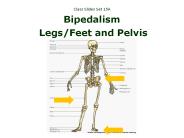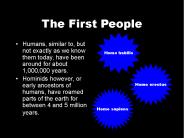Hominids PowerPoint PPT Presentations
All Time
Recommended
Their huge teeth and skulls, often with prominent dorsal crests to which large ... The surviving physical evidence, from skulls such as these, suggests that the ...
| PowerPoint PPT presentation | free to view
Hominids Worksheet 1. A hundred thousand years ago, where did the following groups lived and what is their common name? Homo sapiens neanderthalensis- Europe ...
| PowerPoint PPT presentation | free to view
Each subdivision is associated with a particular group of hominids. Late Australopithecus and early Homo lived during Lower. Homo Erectus spanned most of Middle, ...
| PowerPoint PPT presentation | free to view
... possible in SA. Correlate with Plio-pleistocene fauna at the East African sites. Breccia ... Secondary deposits: Bob Brain. South African sites: 4.4 1.5 mya ...
| PowerPoint PPT presentation | free to view
Time before humans wrote down or recorded records of past events! Prehistory ... Spread from Africa to Eurasia, Australia, and the Americas ...
| PowerPoint PPT presentation | free to view
Hominids and Hunter-Gatherers * * Picture below-Neandertal and Cro-Magnon skulls that were comtemporaries about 40,000 years ago. Both survived the last Ice Age and ...
| PowerPoint PPT presentation | free to download
Evolution of Hominids. Human relatives. The ancestors of our species, based on ... Foramen Magnum Position is under the brain in hominids, toward the back in other ...
| PowerPoint PPT presentation | free to view
Why was Homo erectus so successful? What happened to Neandertals? ... discovered in the Neander Valley (Tal) near Dusseldorf, 1856 ...
| PowerPoint PPT presentation | free to view
High genomic deleterious mutation rates in hominids Eyre-Walker & P. D. Keightley Letters to Nature, Jan. 99
| PowerPoint PPT presentation | free to view
specialize in the studying of the earliest hominids. ( paleo means ' ... Their greatest advantage was the ability to use _. They ate ____ _rhinoceros, ...
| PowerPoint PPT presentation | free to view
Evolutionary Relationships of Hominids Based on Skull Analysis ... Length of temporal fossa. 15.1 10-15. 0-9.9. Space between pterygoids. 36 30-35.9. 0-29.9 ...
| PowerPoint PPT presentation | free to view
Hard-hammer percussion probably most common technique. Production of Oldowan Chopper and resultant flakes using hard-hammer percussion. Flake ...
| PowerPoint PPT presentation | free to view
Early Humans Hominids are the family of mankind and his or her relatives. Hominids are the early ancestors of humans.
| PowerPoint PPT presentation | free to download
The Pinnacle of Evolution? Other Hominids? Bigfoot. Sasquatch. Jersey Devil. Abominable Snowman. Other Hominids? Neanderthal. Homo habilis ...
| PowerPoint PPT presentation | free to view
Humans are hominids, belonging to the taxonomic family Hominidae. Bipedalism, walking on two legs, is ... dermatoglyphics. genetics. anthropometrics. Answer: d ...
| PowerPoint PPT presentation | free to download
Hominids Originated in Africa Early hominids like Homo habilis and Homo ... si.edu/evidence/human-fossils/species/homo-sapiens ... the first system of ...
| PowerPoint PPT presentation | free to view
Humans are hominids, belonging to the taxonomic family Hominidae. ... Anthropometry - measurement of human body parts. Primatology - study of nonhuman primates ...
| PowerPoint PPT presentation | free to download
HUMAN EVOLUTION: GENUS AUSTRALOPITHECUS & PARANTHROPUS Map of Hominid Evolution Why did bipedalism become the primary adaptation of hominids? 1.
| PowerPoint PPT presentation | free to download
Unit One Investigating the Past Chapter One Investigating the Past Prehistory Archeologists Historians Geographers Lascaux Cave Paintings Chapter 2 Early Hominids ...
| PowerPoint PPT presentation | free to download
Chapter 20: Human Evolution - How do humans differ from closely related species? Hominids Upright walking primates (includes monkeys, apes, & humans) Earliest ...
| PowerPoint PPT presentation | free to view
Gibbon. Humans. Lemurs. Hominidae (family) Characteristics of hominids. Bipedal. Rounded jaws ... Walked upright, small stature 3 foot 7 inches and weighed ...
| PowerPoint PPT presentation | free to view
Primate and Human Evolution main points . 1. primates demonstrate a great deal of variation and increasing complexity through time. 2. hominids include present day ...
| PowerPoint PPT presentation | free to view
Chapter 1 Notes Human Beginnings Discovery of Early Americans Important Terms to Know: Prehistory = period of time before people developed writing Hominids ...
| PowerPoint PPT presentation | free to download
... Hunting and Foraging. Glossary. manuport. Early Hominids II ... Time 23 July 2001. Understanding Physical Anthropology and Archaeology, 9th ed., p. 215 ...
| PowerPoint PPT presentation | free to download
Earlier hypothesis emphasized bidpedalism, but that was before we found fossils of other hominids with relatively small brains. Prediction? NY Times review: ...
| PowerPoint PPT presentation | free to download
... (LEED, GB Tool, Green Globe, etc.) Neutral 100% less bad (McDonough) Humans (Hominids) PARTICIPATING AS nature Co ...
| PowerPoint PPT presentation | free to download
Chapter 11 Hominid Origins in Africa Chapter Outline The Bipedal Adaptation Early Hominids from Africa (Pre-Australopithecus Finds) Australopithecus/Paranthropus from ...
| PowerPoint PPT presentation | free to download
The First Humans Hominids are the family of mankind and his or her relatives. Written by Lin Donn Illustrated by Phillip Martin Edited by Richard Owens
| PowerPoint PPT presentation | free to view
The National Museum of Ethiopia (NME), also referred to as the Ethiopian National Museum, is the primary museum in Ethiopia. It is located in the nation's capital, Addis Ababa, near the graduate school of Addis Ababa University. The NME at present has four main exhibition sections. The museum houses the nation's artistic treasures as well as many of the most precious archaeological finds such as the fossilized remains of early hominids, the most famous of which is "Lucy," the partial skeleton of a specimen of Australopithecus afarensis. Recently added to the basement gallery is a display on Selam, found between 2000 and 2004. Estimated to be 3.3 million years old, this A. afarensis specimen is considered to be the earliest child. The NME at present has four main exhibition sections. The basement is dedicated to archaeological and paleoanthropological sections. This area shows the previously mentioned hominids.
| PowerPoint PPT presentation | free to view
PREHISTORY RECAP Prehistory History from the first hominids (5,000,000) to the invention of writing (3,000 BCE). A long period: significant cultural developments are ...
| PowerPoint PPT presentation | free to download
Early Hominids Earliest Humans in East Africa Australopithecus- southern ape 4.4 million years ... of early humans on display in the Hall of Human Origins.
| PowerPoint PPT presentation | free to view
Early Humans 65 Million Years Ago Dinosaurs died out about 65 million years ago. The first human-like hominids did not appear until around 3 million years ago.
| PowerPoint PPT presentation | free to view
Chapter 8 Hominid Origins Chapter Outline Early Primate Evolution Miocene Fossil Hominids Definition of Hominid The Bipedal Adaptation Biocultural Evolution: The ...
| PowerPoint PPT presentation | free to download
Hominid Evolution Bipedal Hominids 4.2 MYA (Dec. 31 9:33 p.m.) * Planetary Evolution Earth and Solar System form 4.5 BYA (Sept. 13) Evolution of Technology
| PowerPoint PPT presentation | free to download
Bones of antelopes, horses, and other animals with cut marks made by ... Signs that hominids scraped & smashed animal bones, like this antelope tibia, 2.5 mya ...
| PowerPoint PPT presentation | free to download
Early Human Migration It is thought that the first hominids appeared in East (1) Africa about 4 million years ago. They were (2) hunter-gatherers and moved from place ...
| PowerPoint PPT presentation | free to view
Hominids human-like species that existed up to several ... Catastrophism no new species evolved. Lamarck. Acquired characteristics. Theory of uniformity ...
| PowerPoint PPT presentation | free to view
18 Outtakes. Johanson and Edey, Lucy (NY: Simon & Schuster, 1981) Johanson and Edey, Lucy (NY: Simon & Schuster, 1981) Early Hominids II. Orrorin. Ardipithecus ...
| PowerPoint PPT presentation | free to download
Understanding Physical Anthropology and Archaeology, 8th ed., p. 217 Possible Factors Influencing the Initial Evolution of Bipedal Locomotion in Hominids.
| PowerPoint PPT presentation | free to download
The First People Homo habilis Humans, similar to, but not exactly as we know them today, have been around for about 1,000,000 years. Hominids however, or early ...
| PowerPoint PPT presentation | free to download
Although anthropologists study hominids (in particular Homo ... Carboniferous. Devonian. Silurian. Ordovician. Cambrian. PALEOZOIC. 136. Cretaceous. MESOZOIC ...
| PowerPoint PPT presentation | free to view
Divisions of Primates. Prosimians ('before ape') Lemurs. Tarsiers. Lorises. Galagos. Lemurs ... African Apes. Chimps. Gorillas. etc... bonobo. Hominids. Homo ...
| PowerPoint PPT presentation | free to download
Hominid Origins in Africa Chapter 11 * * * * * * * * * * * * * * * * Estimated Statures in Plio-Pleistocene Hominids Male Female A. Afarensis 151 cm (59 in.) 105 cm ...
| PowerPoint PPT presentation | free to view
... believe that two different groups of Asian peoples came to North America at ... Early hominids had opposable thumbs. Humans Overcome Their Environment ...
| PowerPoint PPT presentation | free to view
Human Evolution Chapter 32-Mader Overview Evolution of Primates Evolution of Hominids Focus on Homo Human Variation Humans as a selective agent Early Primates ...
| PowerPoint PPT presentation | free to view
... they should be (After other monkeys and apes, before humans and existing apes) ... with a divergence of two types of hominids around 2 mya ...
| PowerPoint PPT presentation | free to view
Human evolution and Evidence. All known hominid (human) fossils ... The various pre-homo hominids are classified in the genus ... for arboreal locomotion ...
| PowerPoint PPT presentation | free to view
MIT-OCW Health Sciences & Technology 508/510. Harvard Biophysics 101. Economics, Public ... Take home: 'High genomic deleterious mutation rates in hominids' ...
| PowerPoint PPT presentation | free to download
Read About Hominids. Please open your History Alive! ... After reading about your hominid, create a work of art in the cave art style ...
| PowerPoint PPT presentation | free to view
Flat face and heavy brow ridges characteristic of much later 'hominids. ... Broad flat (non-prognathus) face. Small molars (not like contemporary ...
| PowerPoint PPT presentation | free to view
Diverged from chimpanzees 5-7 MYA. Hominids evolved in Africa until 2MYA. Homo erectus first widely distributed hominid. Homo sapiens first appears in Africa ~150 KYA ...
| PowerPoint PPT presentation | free to view
Primates evolved from an ancestor that lived 60 m.y.a approx. Important Primate Features ... Hominids are primates that walk on two legs. Walking Tall ...
| PowerPoint PPT presentation | free to view
... hominids to become the masters of their environments, to ... The first tools were ... be particularly useful in the aircraft and civil engineering ...
| PowerPoint PPT presentation | free to view
The study of the life of ancient peoples, as by excavation of ... Historiography. The study of the techniques of historical research. Early Humans. Hominids ...
| PowerPoint PPT presentation | free to view
Primates are mammals with flexible hands and feet, forward-looking eyes and enlarged brains. ... Homonoids are divided into hominids, great apes, and lesser apes. ...
| PowerPoint PPT presentation | free to view
General Features and Major Evolutionary Trends of Apes ... orangutans. bonobos. chimps. gorillas. humans. Campbell and Loy, Humankind Emerging, 8th ed, p. 138f ...
| PowerPoint PPT presentation | free to download
























































